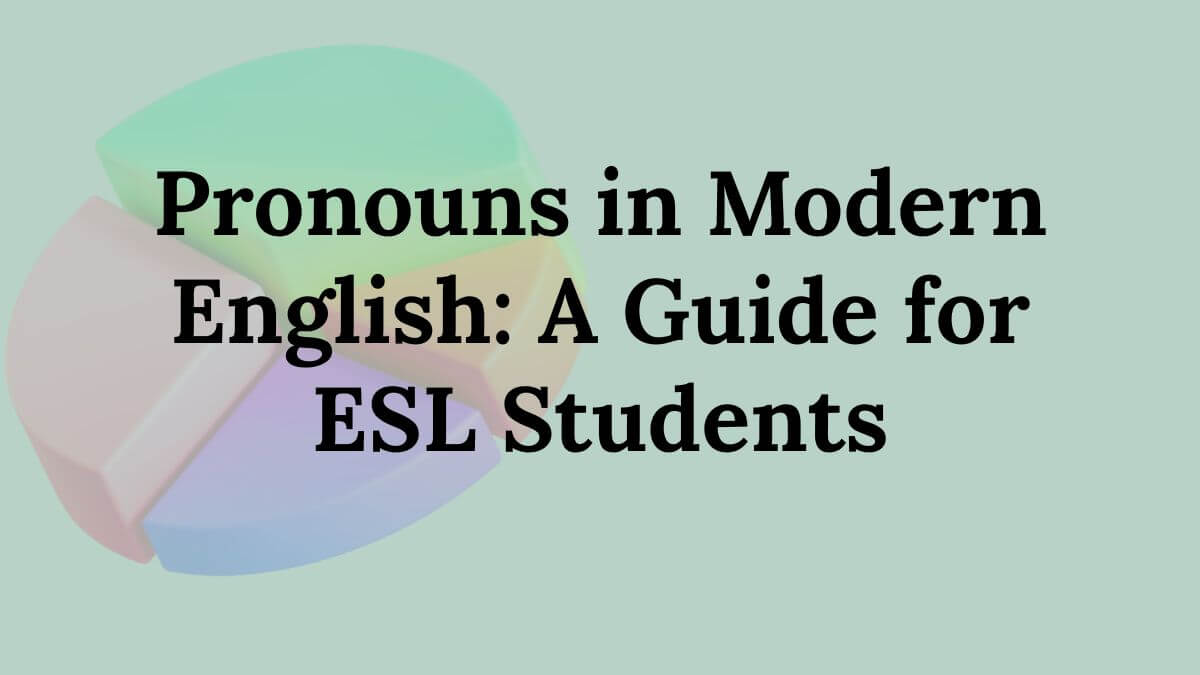Master the use of pronouns in modern English with this clear, friendly guide for ESL learners. Understand types, usage, and practical examples for fluency. Learning pronouns in modern English is essential for anyone studying the language, especially ESL (English as a Second Language) students. Pronouns make communication smoother and sentences easier to follow. Without them, we’d repeat nouns constantly, and that would sound awkward and unnatural. This guide is your go-to resource for understanding how modern English uses pronouns, how they help express identity and clarity, and how you can confidently use them in everyday conversations or writing.
What Are Pronouns?
Pronouns step in for nouns to keep sentences smooth, clear, and less repetitive. Instead of repeating the name of a person, place, or thing, we use pronouns to make language more natural and less repetitive.
For example:
- Instead of: Maria is a teacher. Maria loves books.
- We say: Maria is a teacher. She loves books.
In modern English, pronouns also reflect gender identity, social norms, and formality, making them even more important to learn correctly.
Why Pronouns Matter in Modern English
Clarity and Simplicity
Using pronouns properly helps simplify your speech and writing. Rather than saying the same noun over and over, pronouns allow us to speak more clearly and efficiently.
Respect and Inclusion
In modern English, pronouns have evolved to embrace diversity, reflecting a deeper respect for gender identity and inclusive communication. ESL students should know that using someone’s correct pronouns shows respect and understanding of their identity. Pronouns in Modern English. Pronouns in Modern English
Types of Pronouns in Modern English
1. Personal Pronouns
These refer to people or things and can change form depending on their role in the sentence.
Subject Pronouns (used as the subject):
- I, you, he, she, it, we, and they
Example: She is reading a book.
Object Pronouns (used as the object):
- me, you, him, her, it, us, and them
Example: He saw them at the party.
2. Possessive Pronouns
These show ownership or possession.
Examples: mine, yours, his, hers, ours, theirs
Example: This book is mine.
3. Reflexive Pronouns
Reflexive pronouns are used when the doer and the receiver of the action are the same person.
Examples: Words like myself, yourself, himself, herself, itself, ourselves, yourselves, and themselves are reflexive pronouns, used when someone does something to themselves. Pronouns in Modern English
Example: She taught herself to play piano.
4. Demonstrative Pronouns
Used to point to specific things.
Examples: this, that, these, those
Example: That is my favorite movie.
5. Interrogative Pronouns
Used to ask questions.
Examples: who, whom, whose, which, what
Example: Who is knocking at the door?
6. Relative Pronouns
Used to connect clauses or phrases to a noun or pronoun.
Examples: who, whom, whose, which, that
Example: The student who studies hard will succeed.
7. Indefinite Pronouns
These refer to nonspecific people or things.
Examples: anyone, someone, everybody, nothing, few, many
Example: Everyone is welcome to join.
Modern Trends in Pronoun Usage
1. Gender-Neutral Pronouns
In modern English, people may use they/them as singular pronouns to express a non-binary identity or when the gender is unknown.
Example: Someone left their umbrella. I hope they come back for it.
It’s now common to ask and share pronouns in introductions, especially in inclusive settings.
2. Inclusive Language in Professional Settings
Employers, educators, and public speakers are now more aware of pronouns and often include them in email signatures or name tags. ESL learners should be aware of this trend in both written and spoken English. Pronouns in Modern English
Practical Tips for ESL Students
Start with Personal Pronouns
Mastering personal pronouns is the foundation. Practice simple sentence structures using subject and object pronouns.
Try this:
- I like music. You like dancing. He plays guitar. She sings. We perform. They listen.
Use Context Clues
Understand which pronoun to use by identifying what noun it replaces and its role in the sentence.
Practice with Real Conversations
Listen to native speakers—TV shows, YouTube, or podcasts—and observe how pronouns are used naturally. Then, try to repeat or role-play.
Check for Agreement
Make sure the pronoun agrees with the noun in number (singular/plural) and gender (if known).
Incorrect: Anna took their umbrella.
Correct: Anna took her umbrella.
(Unless Anna uses they/them pronouns, in which case “their” would be correct.)
Common ESL Mistakes with Pronouns
1. Confusing Subject and Object Forms
Incorrect: I like pizza.
Correct: I like pizza.
2. Using Possessive Adjectives as Pronouns
Incorrect: This is my book, and yours is over there.
Correct: This is my book, and yours is over there.
3. Forgetting Agreement
Incorrect: Each student must bring their books.
Correct in modern English (gender-neutral): Each student must bring their books.
(Note: “They/their” is accepted for singular nouns in many modern contexts.)
Pronouns in Modern English Classroom Activities
- Fill-in-the-blank exercises: Help learners practice choosing the right pronoun.
- Sentence transformation: Convert sentences by replacing nouns with pronouns.
- Pronoun matching games: Match subject, object, and possessive forms.
- Role plays: Practice real-life conversations using correct pronouns.
- Pronoun ID cards: Create name cards with pronouns to encourage inclusive introductions.
Read More:
Why Short Sentences Can Make You Sound Better
Basic Sentence Structure Made Easy With Clear Examples
Conclusion
Understanding pronouns in modern English is more than a grammar rule—it’s a key to respectful, fluent communication. Whether you’re speaking with friends, writing essays, or joining a professional meeting, using the right pronouns helps you sound natural and respectful. For ESL students, mastering pronouns takes time and practice, but it’s one of the most rewarding steps in your English-learning journey. Start small, practice daily, and you’ll become more confident every day. Pronouns in Modern English
